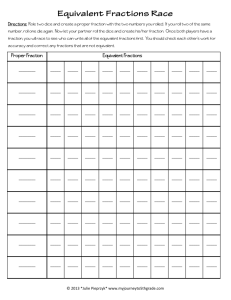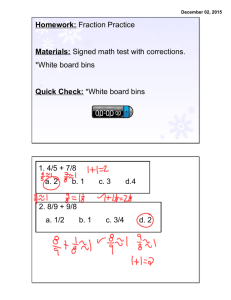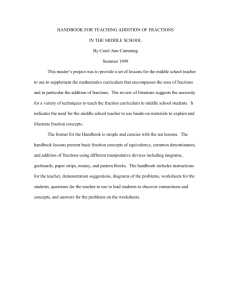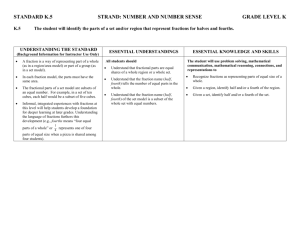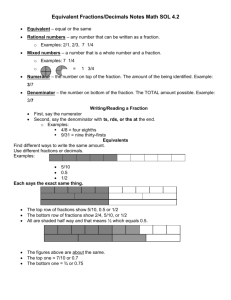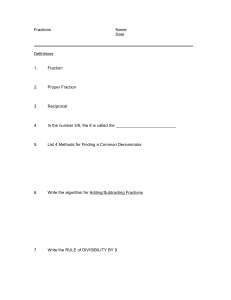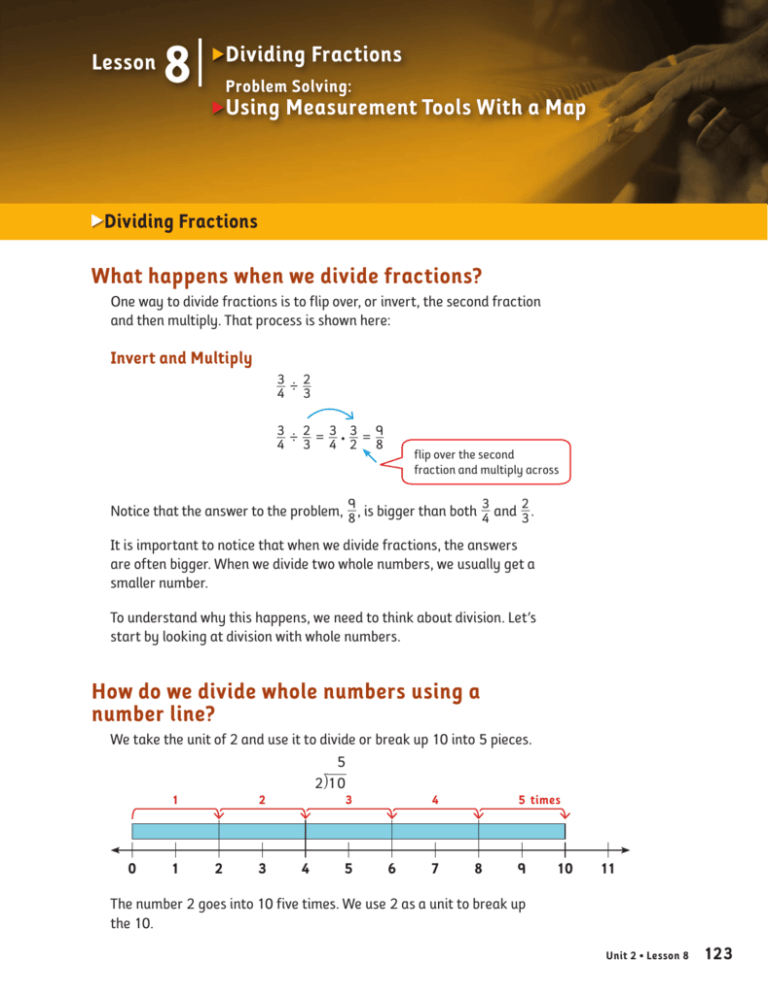
Lesson
8 Dividing Fractions
Problem Solving:
Using Measurement Tools With a Map
Dividing Fractions
What happens when we divide fractions?
One way to divide fractions is to flip over, or invert, the second fraction
and then multiply. That process is shown here:
Invert and Multiply
3 2
4÷3
3 2 3 3 9
4÷3=4·2=8
flip over the second
fraction and multiply across
3
2
Notice that the answer to the problem, 9
8 , is bigger than both 4 and 3 .
It is important to notice that when we divide fractions, the answers
are often bigger. When we divide two whole numbers, we usually get a
smaller number.
To understand why this happens, we need to think about division. Let’s
start by looking at division with whole numbers.
How do we divide whole numbers using a
number line?
We take the unit of 2 and use it to divide or break up 10 into 5 pieces.
5
2q10
1
0
1
2
2
3
3
4
5
4
6
7
5 times
8
9
10
11
The number 2 goes into 10 five times. We use 2 as a unit to break up
the 10.
Unit 2 • Lesson 8 123
Lesson 8
Now let’s look at how we divide using a fraction.
How do we divide fractions using a
number line?
This number line is
stretched out so that we
can see what we are doing
when we divide 1
2 into 3.
Let’s use a number line to solve the problem:
1
2 q3
1
0
2
1
2
3
1
4
1 12
5
2
6 times
2 12
3
We take the unit 1
2 and divide it into 3. We can divide, or break up,
3 into 6 parts when we divide by 1
2.
We can also think of it as finding the number of halves in 3. There are 6
halves in 3. It is important for us to notice that the answer, 6, is bigger
than both 1
2 and 3.
The number line helps us see why the quotient is bigger than either
fraction. When we divide by 1
2, we are breaking 3 into units that are
1
smaller than 1. Each unit is 2 of the whole in length. There are 6 of
these units. That is why we get a bigger number when we divide with
fractions.
One important thing to remember when we are working with fractions
and whole numbers is that we rewrite the whole numbers as
fractions with 1 in the denominator. So, 3 = 3
1.
Here is how we write a problem like the one above using fractions.
3 1
1 ÷ 2 =6
124 Unit 2 • Lesson 8
3 12
Lesson 8
How do we use fraction bars to show division?
We can also use fraction bars to look at the problem 3 ÷ 1
2 = 6.
We start with 3 whole fraction bars placed end-to-end. Then we use 1
2
of a fraction bar to divide into the 3 bars.
The unit 1
2 is shaded.
Three whole fraction bars
Now let’s divide: 3 ÷ 1
2 = 6.
The 1
2 fraction bar divides the 3 whole fraction
bars. It breaks the 3 bars into 6 parts.
1
2
3
4
5
6 times
halves
3
The answer 6 is bigger than the numbers we started with, 3 and 1
2.
It is bigger because we are dividing by a unit that is smaller than 1.
This happens whenever we divide by a proper fraction. Remember, the
answer is bigger because we are finding out how many small parts, or
fractions, there are in the number. In this problem, we used 1
2 to break
up 3 six times.
Number lines and fraction bars help us look at division because we can
see parts more easily.
Apply Skills
Turn to Interactive Text,
page 68.
It’s important to
understand that
division is about
finding parts of a
number.
Reinforce Understanding
Use the mBook Study Guide
to review lesson concepts.
Unit 2 • Lesson 8 125
Lesson 8
Problem Solving: Using Measurement Tools With a Map
How do we use measurement tools with a map?
In Lesson 4, we discussed how surveyors use angles to measure the
steepness of a road. Another type of worker who uses this kind of
measurement is a city planner. City planners make recommendations
about where buildings and other structures should be located. They
determine this by looking at where all the buildings, parks, stadiums,
housing developments, and so on, are in a particular city. City planners
then record all of the information about the city.
We can use a protractor to measure the angles on the map. The angles
and their measurements are listed in the table below.
C
B
D
A
High School
F
E
G
Police Station
L
K
M
I
Grocery Store
H
City Hall
Fire Station
J
N
Pharmacy
Angle Name
∠BFC
∠KIF
∠IGJ
∠DEH
∠JNP
Problem-Solving Activity
Turn to Interactive Text,
page 69.
126 Unit 2 • Lesson 8
P
Elementary
School
Estimated Measurements
50°
100°
130°
55°
90°
Reinforce Understanding
Use the mBook Study Guide
to review lesson concepts.
Lesson 8
Homework
Activity 1
Solve the problems by multiplying across and simplifying.
1.
2
6
· 12
2. 3 · 3
3
5.
3
9
· 35
6. 12 · 2
4
1
3.
1
2
4
· 14
4.
2
4
· 23
3
1
8.
4
8
· 12
7. 9 · 3
Activity 2
Use the fraction bar to help solve the division problems.
1
2
1
2. 2 ÷ 3
1. 3 ÷ 3
3
1
4
2
2
3. 4 ÷ 3
4. 2 ÷ 3
Activity 3
Identify the angle. Write a, b, or c on your paper.
1.
2.
(a) Acute
(b) Right
(c) Obtuse
(a) Acute
(b) Right
(c) Obtuse
3.
4.
(a) Acute
(b) Right
(c) Obtuse
(a) Acute
(b) Right
(c) Obtuse
Activity 4 • Distributed Practice
Solve.
1.
1
6
+ 18
7
24
2
1
2. 3 + 6
5
6
3.
4
5
9
5
+ 55
4
5
4.
11
12
− 56
1
12
Copyright 2010 by Cambium Learning Sopris West®. All rights reserved. Permission is granted to reproduce this page for student use.
Unit 2 • Lesson 8 127


